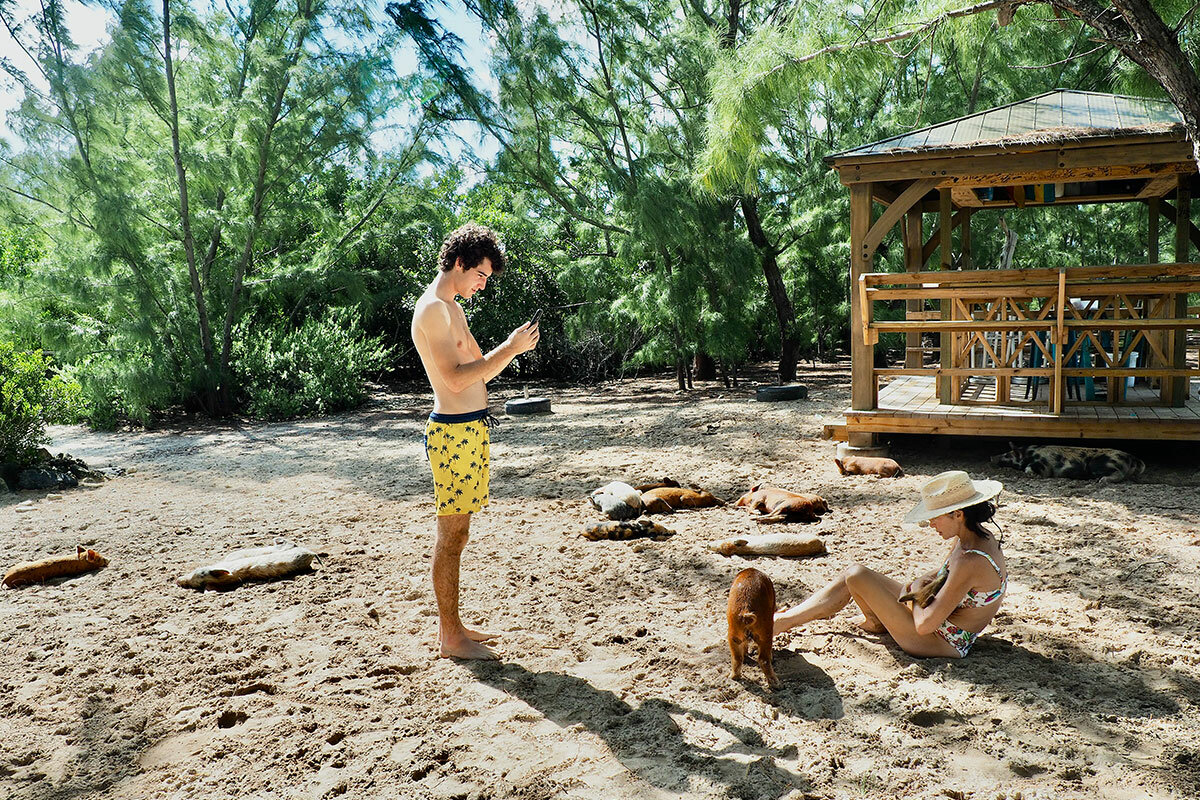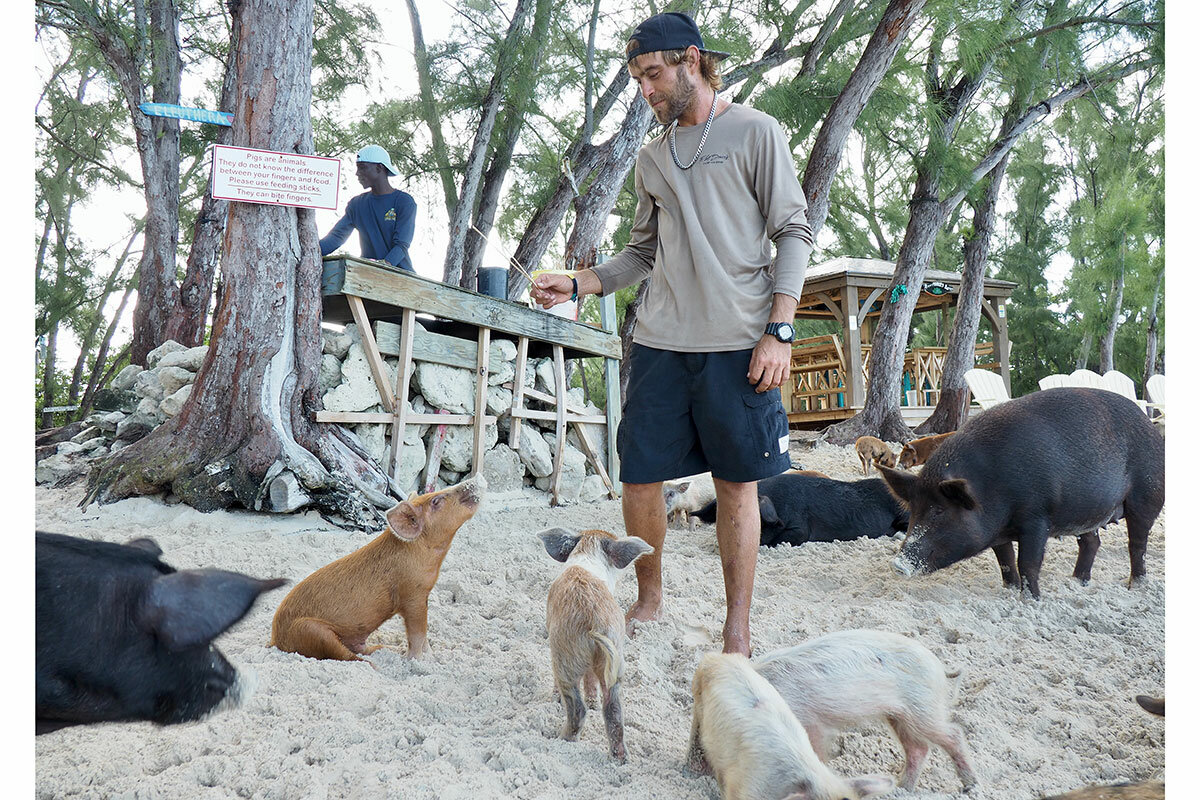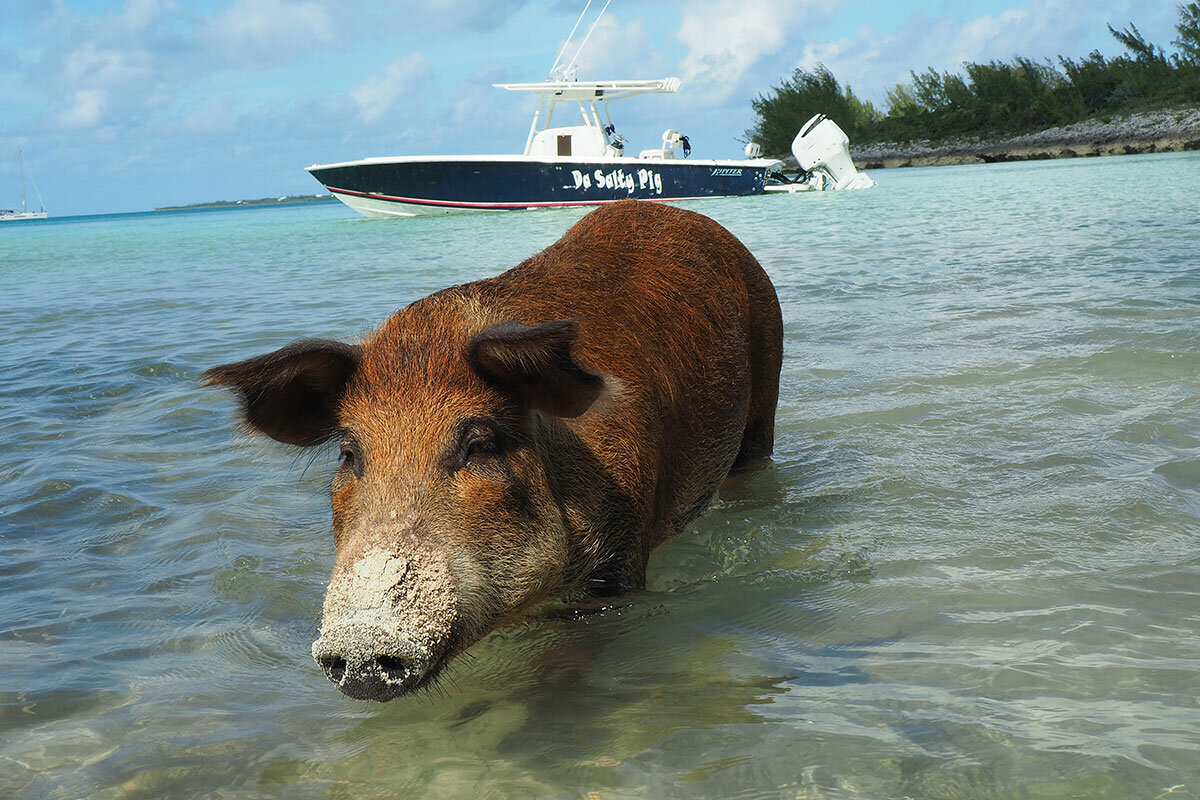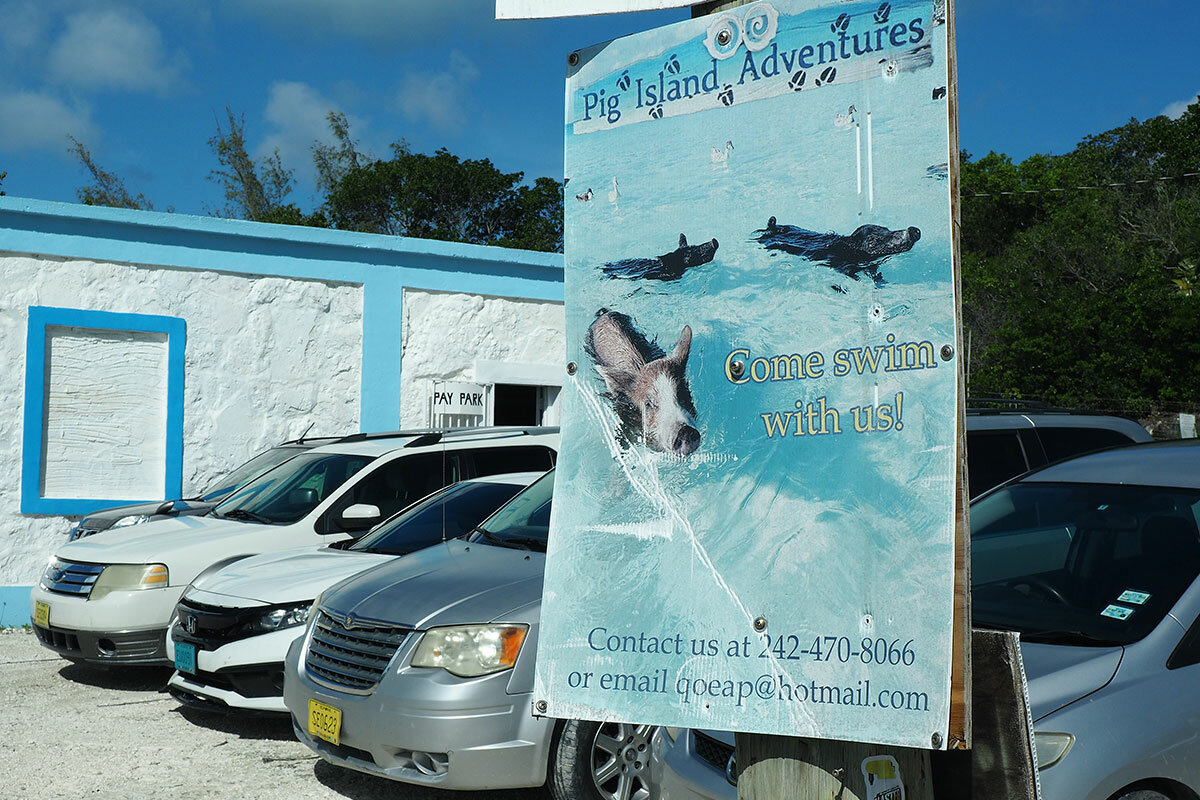When pigs swim ... and Bahama tourists dive in with them
Loading...
| PIG ISLAND, Eleuthera, Bahamas
It was another day in paradise for Wilbur, Midnight, Frank, and family when captain Roy Pinder appeared in his gleaming white boat, motoring toward their sugar-sand beach.
They looked up, perhaps curiously, perhaps expectant.
Or perhaps they were just bored. This, after all, was not the first boat to arrive at their narrow island.
Why We Wrote This
A story focused onSometimes joy arrives in unexpected ways. In the Bahamas, which have long boasted sparkling beaches and turquoise waters, the hottest attractions now have snouts, hoofs, and a willingness to hang out with humans.
Mr. Pinder (or Crazy Roy, as he’s known in these parts) anchored a short distance offshore. His guests, a family from Los Angeles, slipped excitedly into the turquoise water, smartphones lifted above the gentle waves.
As the visitors neared the sand, Frank and friends hoisted themselves up, tilted their heads, and began ambling toward the water. Soon, they were in the surf, paddling over to the Angelenos.
The visitors let out delighted shrieks. They took photos. They took selfies. They gasped and giggled.
“Go on,” Mr. Pinder said, handing out sticks with chicken dogs. “You can feed them.”
The visitors happily obliged.
“Can I pick him up?”
“Oh my gosh, sooooooo cute!”
Gina Goldman cradled one of Frank’s youngest relations like a baby.
“Walter,” she called to her husband. “Congratulations,” she said, showing the new little one in their care.
This, it turns out, is what happens when pigs swim.
For that’s what Frank, Wilber, and crew are – pigs. Not a unique breed of wild Caribbean pigs. Not a long-lost species of water pigs. They’re just pigs. On a beach. In the Bahamas. And they swim. Because, it turns out, pigs can do that.
But they are something more, as well; something that speaks to joy, our relationship with animals, economics, and, perhaps, just plain weirdness. For the past seven years, this head-scratching combination of surf, sun, and swine – or “swimming with the pigs,” as it is advertised – has become one of this country’s most popular and promoted tourism attractions, one that seems poised to expand even further throughout the Caribbean.
Indeed, since the first pig excursions began in the mid-2010s in the Exumas, a relatively remote chain of islands here, the activity has exploded in popularity. Every major island in the Bahamas now has a pig beach. Cruise ship companies with their own resorts and private beaches have their own private pigs. Visitors to the Bahamas disembark from their planes in Nassau and walk by floor-to-ceiling photographs of pigs on the way to baggage claim.
And tourists like Ms. Goldman and her family seek out the experience.
“We don’t like to resort travel,” she said, still stroking the now-sleeping piglet’s head. “We like to adventure. Once we heard there were pigs here, we couldn’t get here fast enough.”
According to some reports, pig tourism brings tens of millions of dollars into the Bahamian economy. And now the phenomenon may be spreading further. Recently, entrepreneurs in the neighboring island of Antigua started advertising their own pig beach attraction, called Pigs Paradise. (This caused not a little eye rolling among Bahamians, who had already claimed the title Pigs of Paradise.)
“It works everywhere,” says Brady Darius Perry, a Bahamian boat captain whose family owns Da Salty Pig charters out of Spanish Wells, at the northern end of the island of Eleuthera. He and his family, who had been in the lobstering industry, helped import pigs to this beach after a hurricane wiped out their fishing equipment. “People really like it. Most of the time that’s what they come here to see – the pigs.”
It was never supposed to be this way, says T.R. Todd, an author and public relations executive who, in some ways, is responsible for the porcine craze.
Beach + pigs = marketing magic
Once a journalist based in Nassau, the capital city here, Mr. Todd only heard about the pigs after he had started a marketing job with Peter Nicholson, a Canadian developer with projects in the Exumas. He remembers doing a double take when Mr. Nicholson off-handedly mentioned the swimming pigs who lived on one of the nearby, otherwise uninhabited islands.
Swimming pigs? Mr. Todd remembers asking. What?
It turned out there were quite a few rumors about these creatures, he recalls. Some people said they were left over from the pirates who once hid in the islands. Others suspected that the pigs were shipwreck survivors. But most people believed they were put there by local homesteaders who wanted pigs, but not the stench or conflict with neighbors that pigs can entail.
Whatever the reason, the animals had started to amuse some of the residents, and then some of the tourists, particularly because they paddled out to the boats that stopped by, hoping to get some food.
Mr. Todd realized immediately that there was a marketing opportunity here; something different than the normal palm trees and bikinis and sun-drenched beaches. And so he began promoting the “swimming pigs” and arranging ways for tourists to see them.
At first, some of the neighboring resorts were decidedly not on board. Pigs did not fit into their upscale brand, they insisted. But it turned out that the high-end guests adored the pigs. And then, in 2016, the reality show “The Bachelor” filmed an episode in the Exumas, in part thanks to the invitation of Mr. Todd, his employer, and the Bahamian government. And one of the key dates on the show was with the pigs.
That show launched the swimming pigs into full celebrity status.
“It really blew up,” Mr. Todd recalls. “That’s when the government realized, this is lightning in a bottle. It just spread, and it spread really quickly.”
Part of the appeal, he theorizes, is the juxtaposition of beach and, well, pig – an animal that is both loved and reviled, and typically associated with mud pits and filth.
“The Bahamas is gorgeous,” he says. “It’s crystal clear and so pristine; when you see a pig ...”
It also suggests the joy humans get from connecting with animals, he says, as well as a widespread desire for surprise and novelty.
And then, of course, there’s social media.
A selfie with a pig is pretty much at the top of the bucket list for tourists who come to the Bahamas, according to multiple boat captains here. And sure enough, scroll through the websites for Bahamian charter companies and tour operators and there is photo after photo of human with pig; search for “swimming pigs” on Instagram and there are thousands of similar shots.
Exploitation, or bonding?
This popularity has started to create some controversy. In 2017, pigs on the original Pig Beach in the Exumas began dying; government officials and some animal rights groups suspected mistreatment from tourists – or at least overfeeding – as a cause. (Veterinarians who investigated believe a combination of factors, including dehydration, were likely responsible.)
Since then, a local group called the Swimming Pig Association has been monitoring and caring for the Exumas pigs, who, according to Mr. Todd, are today as healthy and happy as one might expect a pig on a beach to be. But there is still some pushback. “Pig attacks” have been caught on camera – instances where pigs, seemingly annoyed by endless selfies, have turned around and nipped the tourists making fishy faces with them. Some vegan groups have suggested that the pig tourism is exploitative and have encouraged visitors to keep their distance.
(Less exploitative than bacon, says Jesse Higgs, one of the pig trainers and caretakers on Pig Island off Eleuthera. His colleague, Andre Pierre, shrugs. “Pigs are gangsters,” Mr. Pierre says.)
Still, the vast majority of pig experiences are peaceful, according to those in the tourism industry. And the pigs themselves fare far better than their compatriots, they suggest. At Pig Island, for instance, Mr. Higgs and Mr. Pierre keep watch over the pigs – making sure they are fed, watered, and comfortable. They train the residents to swim, roll over, sit, and stay, and they keep a close watch for any signs of aggression.
They admit to having wondered at first about tourists’ fascination with the pig.
(Mr. Pinder, the boat captain, still has some skepticism. “I don’t know why they like them,” says the former lobsterman. “Cuz I don’t. Except on my plate.”)
But now that they’ve spent time with the creatures, they understand, they say. There is, indeed, something simply joyful about pigs on a beach.
“I love it,” Mr. Higgs says. “They all have different personalities.” The pig named Brownie, for instance, is his favorite. “I can’t call it work no more.”










